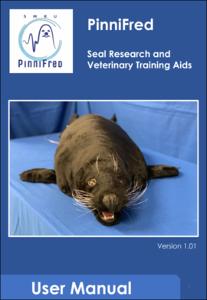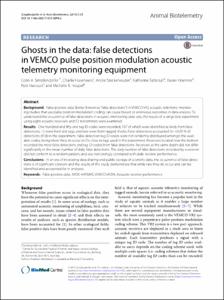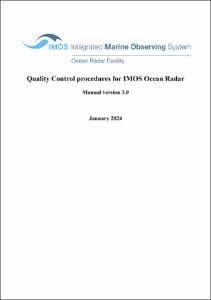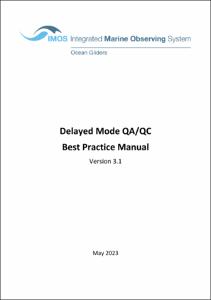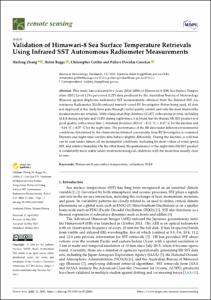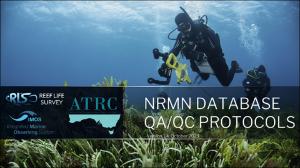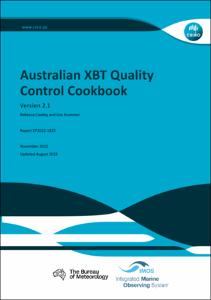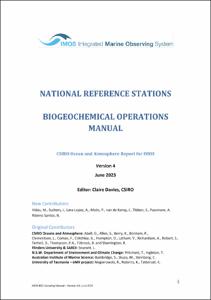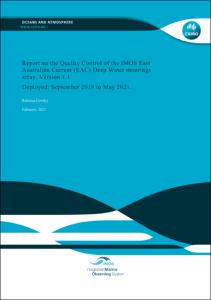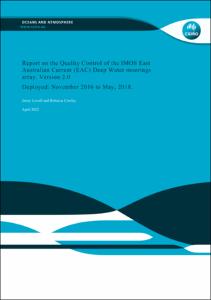⇒ IMOS: Integrated Marine Observing System
Browse by
Since 2006, IMOS has been routinely operating a wide range of observing equipment throughout Australia’s coastal and open oceans, making all of its data accessible to the marine and climate science community, other stakeholders and users, and international collaborators.
Collections in this community
Recent Submissions
-
Towards a best practice in acoustic telemetry mooring design.
(Ocean Tracking Network (OTN) and Integrated Marine Observing System (IMOS), Dalhouse, Canada, 2025)This document presents trialled and tested, best practice methods for the subsea deployment of acoustic telemetry equipment developed by two of the world’s longest operating animal telemetry networks, the Ocean Tracking ... -
Surface water CO2 measurements from ships of opportunity, A report for Australia’s Integrated Marine Observing System.
(CSIRO, Hobart, Australia, 2024)Underway measurements of the fugacity of carbon dioxide (fCO2) in surface waters and the atmosphere are made using General Oceanics Incorporated Model 8050 or 8060 systems (GO) equipped with LI-COR gas analysers. -
System Description and Procedures for Moored Biogeochemical Measurements Manual. Version 1.0.
(2023)This document serves as the description and quality-control manual for the IMOS Acidification Moorings Sub-Facility, a component of IMOS's National Mooring Network. It includes details on mooring locations, mooring design, ... -
Best Practice Manual for SMRU CTD Satellite Relay Data Loggers: Instrument Calibration, Near Real-Time and Delayed Mode Data QA/QC. Version 1.0. [ENDORSED PRACTICE]
(Integrated Marine Observing System (IMOS), Hobart, Australia, 2024)This document is the IMOS Animal Tracking Facility’s Best Practice manual for near real-time and delayed-mode processing of physical and behavioural observations collected using Sea Mammal Research Unit CTD Satellite Relay ... -
PinniFred: Seal Research and Veterinary Training Aids - User Manual. Version 1.01.
(Sea Mammal Research Unit, University of St Andrews, St Andrews, Scotland, 2023)PinniFred is a unique training tool designed for seal veterinary, conservation and research staff. We believe that by learning with PinniFred you will quickly improve the knowledge, skills and competency of staff, as ... -
Report on the Quality Control of the IMOS East Australian Current (EAC) Deep Water moorings array. Deployed: May 2021 to July 2022. Version 2.0.
(Commonwealth Scientific and Industrial Research Organisation (CSIRO), Hobart, Australia, 2024)The East Australian Current (EAC) is a complex and highly energetic western boundary system in the south-western Pacific off eastern Australia. It provides both the western boundary of the South Pacific gyre and the ... -
Cardno OceanSense Wave Data Quality Manual - Bureau of Meteorology Wave Buoy Support - Version Rev A
(Cardno (NSW/ACT) Pty Ltd, 2017)Manual for wave buoys, covering measurements, calibration software, wave parameter definitions, automatic QC/QA configuration, and technical support. -
Ghosts in the data: false detections in VEMCO pulse position modulation acoustic telemetry monitoring equipment
(2015)False-positive data (better known as "false detections") in VEMCO VR2 acoustic telemetry monitoring studies that use pulse position modulation coding can cause biased or erroneous outcomes in data analysis. To understand ... -
Quality Control procedures for IMOS Ocean Radar Manual, Version 3.0.
(Integrated Marine Observing System (IMOS), Hobart, Australia, 2024)The IMOS Ocean Radar Facility Quality-Control and Data User’s Manual is a comprehensive guide designed for individuals utilizing the Facility's data. A crucial element within Australia’s Integrated Marine Observing System ... -
Delayed Mode QA/QC Best Practice Manual Version 3.1
(Integrated Marine Observing System (IMOS), Hobart, Australia, 2023)This document is the IMOS Ocean Gliders (formerly known as Australian National Facility for Ocean Gliders (ANFOG)) Best Practice manual for delayed mode processed data. IMOS Ocean Gliders is a facility under Australia’s ... -
Validation of Himawari-8 Sea Surface Temperature Retrievals Using Infrared SST Autonomous Radiometer Measurements
(2023)This study has evaluated five years (2016–2020) of Himawari-8 (H8) Sea Surface Temperature (SST) Level 2 Pre-processed (L2P) data produced by the Australian Bureau of Meteorology (Bureau) against shipborne radiometer SST ... -
GHRSST compliant AVHRR SST products over the Australian region
(2017)The Australian Bureau of Meteorology produces a Group for High Resolution Sea Surface Temperature (GHRSST) compliant Sea Surface Temperature (SST) dataset over the Australian region, based on direct measurements from ... -
NRMN Database QA/QC Protocols. Version 1.4
(Integrated Marine Observing System (IMOS), Hobart, Australia, 2023)This document describes the management and QA/QC processes for the National Reef Monitoring Network data. The NRMN provides publicly accessible data for shallow reef biodiversity on a global scale, integrating high quality ... -
Australian XBT Quality Control Cookbook Version 2.1.
(CSIRO, Hobart, Tasmania, Australia, 2023)Expendable Bathythermographs (XBTs) have been used for many years by oceanographers to measure the temperature of the upper ocean. These instruments are simple devices which are designed to be deployed from moving vessels, ... -
Australian Wave Buoy Operations and Data Management Guidelines.
(Integrated Marine Observing System (IMOS), Hobart, Australia, 2023)This is a reference and guidance document for existing and prospective wave buoy operators and wave buoy data users in Australia. The document outlines wave buoy instruments most commonly in use and the wave data types and ... -
National Reference Stations Biogeochemical Operations Manual. Version 4.
(Integrated Marine ObservIng System (IMOS), Hobart, Australia, 2023)This manual outlines best-practice techniques in biogeochemical and blue-water oceanography for ensuring the output of reliable, quality data to the end-user community. The aim is for sampling, analytical, and reporting ... -
Report on the Quality Control of the IMOS East Australian Current (EAC) Deep Water moorings array. Deployed: September 2019 to May 2021. Version 1.1.
(Commonwealth Scientific and Industrial Research Organisation (CSIRO), Hobart, Australia, 2023)The East Australian Current (EAC) is a complex and highly energetic western boundary system in the south-western Pacific off eastern Australia. It provides both the western boundary of the South Pacific gyre and the ... -
Report on the Quality Control of the IMOS East Australian Current (EAC) Deep Water moorings array. Deployed: April/May 2018 to September, 2019. Version 1.4.
(Commonwealth Scientific and Industrial Research Organisation (CSIRO), Hobart, Australia, 2023)The East Australian Current (EAC) is a complex and highly energetic western boundary system in the south-western Pacific off eastern Australia. It provides both the western boundary of the South Pacific gyre and the ... -
Report on the Quality Control of the IMOS East Australian Current (EAC) Deep Water moorings array. Deployed: November 2016 to May 2018. Version 2.0.
(Commonwealth Scientific and Industrial Research Organisation (CSIRO), Hobart, Australia, 2022)The East Australian Current (EAC) is a complex and highly energetic western boundary system in the south-western Pacific off eastern Australia. It provides both the western boundary of the South Pacific gyre and the ... -
Report on the Quality Control of the IMOS East Australian Current (EAC) Deep Water moorings array. Deployed: May 2015 to November 2016. Version 3.2.
(Commonwealth Scientific and Industrial Research Organisation (CSIRO), Hobart, Australia, 2022)The East Australian Current (EAC) is a complex and highly energetic western boundary system in the south-western Pacific off eastern Australia. It provides both the western boundary of the South Pacific gyre and the ...
 Repository of community practices in Ocean Research, Applications and Data/Information Management
Repository of community practices in Ocean Research, Applications and Data/Information Management



